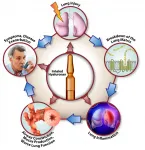(Press-News.org) Chronic stress could be the prevailing condition of our time. In the short term, our jaws or stomachs may clench; in the long term, stress can lead to metabolic disease and speed up diseases of aging, as well as leading to more serious psychological disorders. The physical manifestations of stress originate in the brain, and they move along a so-called "stress axis" that ends in the adrenal glands. These glands then produce the hormone cortisol. When the stress axis is continually activated, changes occur in the cells and organs along the way, and the continual production of cortisol then substantially contribute the symptoms of chronic stress.
The stress response axis starts with the hypothalamus in the brain, moves through the pituitary right next to the brain and then on to the adrenal glands near the kidneys. Scientists at the Weizmann Institute of Science in Israel and the Max Planck Institute of Psychiatry in Germany used new technology to view the entire stress axis as it has never before been seen. Their findings, which were published in Science Advances may be relevant to a number of stress-related diseases from anxiety and depression to metabolic syndrome and diabetes.
The new study, led by postdoctoral fellow Dr. Juan Pablo Lopez in the joint neurobiology lab of Prof. Alon Chen in the Weizmann Institute of Science and the Max Planck Institute of Psychiatry, made use of a relatively new technique that allows researchers to identify differences across all cell types in a tissue. This method is something like identifying the individual fruits in a bowl of fruit salad - rather than the standard methods of turning that fruit salad into a "smoothie" and then trying to identify the average characteristics of all the fruits together. But in this case, the task was much more complex than separating the apples from oranges: Pablo Lopez and the team mapped the entire length of the stress axis, checking the activities of numerous single cells all along the route. And they conducted this analysis on two sets of mice - one unstressed and one exposed to chronic stress.
All in all, the team mapped 21,723 cells along the three points in that axis, and they compared their findings from the two sets of mice. They noted that as the stress message moved from one organ to the next, the gene expression in the cells and the tissues themselves underwent greater changes. The team found 66 genes that were altered between normal and stressed mice in the hypothalamus, 692 in the pituitaries and a whopping 922 in the adrenals. The adrenals are glands that can change their size visibly under chronic stress exposure, and it was here that the researchers noted the most significant alterations among the various cells.
The unprecedented resolution of the technique enabled the researchers to identify, for the first time, a subpopulation of adrenal cells that may play a crucial role in the stress response and adaptation. These were endocrine cells sitting in the outer layer, or adrenal cortex. Among other things, the team identified a gene, known as Abcb1b, and found it to be overexpressed in these cells under stress situations. This gene encodes a pump in the cell membrane that expels substances from the cell, and the scientists think it plays a role in the release of cortisol. "If extra stress hormones are created, the cell needs extra release valves to let those hormones go," says Pablo Lopez.
Are the findings in mice relevant to humans? In collaboration with researchers in university-based hospitals in the UK, Germany, Switzerland and the US, the scientists obtained adrenal glands that had been removed from patients to relieve the symptoms of Cushing's disease. Though the disease is the result of a growth on the pituitary, the result can be identical to chronic stress - weight gain and metabolic syndrome, high blood pressure and depression or irritability - so in some cases it is treated by removing the adrenal glands, thereby reducing the patients' stress hormone load. Indeed, the cells in these patients' adrenals presented a similar picture to those of the mice in the chronic stress group.
The gene they had identified, Abcb1, was known to the researchers from previous studies into the genetics of depression. It had been found that this gene is polymorphic - it has several variants - and that at least one version is tied to a higher risk for depression. The group analyzed the expression of this variant in blood tests taken from a group of subjects who suffer from depression and who were subjected to temporary stress. They found that certain variants do, indeed, affect the ways the adrenal glands deal with stress signals coming down the axis.
Chronic stress, of course, can ultimately affect every part of the body and open the door to numerous health issues. The new study, because it looks at the entire axis, on the one hand, and has mapped it down to the gene expression pattern of its individual cells, on the other, should provide a wealth of new information and insight into the mechanisms behind the stress axis. "Most research in this field has focused on chronic stress patterns in the brain," says Prof. Chen. "In addition to presenting a possible new target for treating the diseases that arise from chronic stress, the findings of this study will open new directions for future research."
INFORMATION:
Prof. Alon Chen's research is supported by the Ruhman Family Laboratory for Research in the Neurobiology of Stress; and Bruno Licht. Prof. Chen is the incumbent of the Vera and John Schwartz Professorial Chair in Neurobiology.
The Weizmann Institute of Science in Rehovot, Israel, is one of the world's top-ranking multidisciplinary research institutions. Noted for its wide-ranging exploration of the natural and exact sciences, the Institute is home to scientists, students, technicians and supporting staff. Institute research efforts include the search for new ways of fighting disease and hunger, examining leading questions in mathematics and computer science, probing the physics of matter and the universe, creating novel materials and developing new strategies for protecting the environment.
Scientists say stable seafood consumption amongst the world's poorer coastal communities is linked to how local habitat characteristics influence fishing at different times of the year.
In the coastal communities of low-income countries, the seafood people catch themselves is often a main food source. In a new study, scientists focused on an often-overlooked type of fishing called gleaning: collecting molluscs, crabs, octopus and reef fish by hand close to shore.
"We surveyed 131 households in eight coastal communities on a small island off Timor-Leste," said study lead author Ruby Grantham from the ARC Centre of Excellence for Coral Reef Studies.
Grantham said even though gleaning is important for food security ...
(Boston)--There have been great advances in treating melanoma over the past five years, however, even with these treatments many patients quickly develop drug resistance and die from their disease. A new study from Boston University School of Medicine (BUSM) has discovered that a drug (YK-4-279) that was previously created to target one specific type of protein has much broader use against a family of proteins that act to promote melanoma.
"We find that this drug inhibited melanoma from becoming more aggressive in human cells and in experimental models. We also found a specific pathway that this drug acts through to be anti-cancer: inhibiting proteins that drive genes that promote cancer cell growth and metastasis," ...
COLUMBUS, Ohio - Antarctic ice is melting, contributing massive amounts of water to the world's seas and causing them to rise - but that melt is not as linear and consistent as scientists previously thought, a new analysis of 20 years' worth of satellite data indicates.
The analysis, built on gravitational field data from a NASA satellite system, shows that Antarctica's ice melts at different rates each year, meaning the models scientists use to predict coming sea level rise might also need adjusting.
"The ice sheet is not changing with a constant rate - it's more complicated than a linear change," said Lei Wang, assistant professor ...
Researchers from North Carolina State University and the University of Texas have developed and demonstrated a new approach for designing photonic devices. The advance allows them to control the direction and polarization of light from thin-film LEDs, paving the way for a new generation of virtual reality (VR) and augmented reality (AR) technologies.
"This is a fundamentally new device architecture for photonic devices," says Franky So, corresponding author of a paper describing the work. "And we've demonstrated that, using our approach, directional and polarized emissions from an organic LED or a perovskite LED without external optical elements can be realized." So is the ...
Researchers at the National Institutes of Health and their collaborators found that inhaling unfragmented hyaluronan improves lung function in patients suffering from severe exacerbation of chronic obstructive pulmonary disease (COPD). Hyaluronan, a sugar secreted by living tissue that acts as a scaffold for cells, is also used in cosmetics as a skin moisturizer and as a nasal spray to moisturize lung airways. Utilized as a treatment, hyaluronan shortened the amount of time COPD patients in intensive care needed breathing support, decreased their number of days in the hospital, and saved money by reducing their hospital stay.
The study, published online in Respiratory Research, is a good example of how examining the impacts of environmental pollution on the lungs can ...
Self-control significantly affects well-being and objective success in life. Although many agree that a high degree of self-control is beneficial, helping people develop more self-control is a tricky challenge. Self-control training, like training in any domain, is affected by the basic question of whether a person is motivated to improve self-control. Recent work has found that people differ as to how strongly they desire better self-control, and reveals some of the factors affecting this desire.
Desire for self-control (DSC) reflects a wish to have an improved self-control ability. This desire is influenced by societal or cultural ...
HOUSTON - (Feb. 1, 2021) - When aboveground storage tanks fail during a storm and their toxic contents spread, the threat to human health can and probably will flow downwind of the immediate area.
Rice University engineers have developed a model to quantify what could happen when a hurricane or other natural disaster causes such damage based on data gathered from the Houston Ship Channel, the largest petrochemical complex in the United States, during and after two hurricanes, Ike in 2008 and Harvey in 2017.
Pollutants like toxic organic chemicals evaporate ...
There is a considerable gap in our current understanding of gift-giving because much of what has been studied has focused on gift-giving as an affair between just two consumers--a single giver and a recipient. Little is known about the impact other gifts have on the recipient of the gifts, even though some of the most common occasions for giving a gift, such as birthdays, the winter holidays, Mothers' and Fathers' Day, graduations, bridal showers, baby showers, bachelor and bachelorette parties, going away parties, and retirement parties, all typically involve a recipient receiving gifts from several different givers.
Researchers from ...
(DENVER--February 1, 2021, 10:00 a.m. EST) The first comprehensive, prospective study of smoking habits in patients with non-small cell lung cancer (NSCLC) who were enrolled in a phase III early-stage trial revealed that there was a high rate of smoking reduction and cessation following study entry, according to research published today in the Journal of Thoracic Oncology. The JTO is the official journal of the International Association for the Study of Lung Cancer.
Continued smoking after a lung cancer diagnosis is associated with an approximate ...
Good news: The bacteria living on your toothbrush reflect your mouth - not your toilet.
After studying microbial communities living on bristles from used toothbrushes, Northwestern University researchers found those communities matched microbes commonly found inside the mouth and on skin. This was true no matter where the toothbrushes had been stored, including shielded behind a closed medicine cabinet door or out in the open on the edge of a sink.
The study's senior author, Erica Hartmann, was inspired to conduct the research after hearing concerns that flushing a toilet might generate a cloud of aerosol particles. She ...




